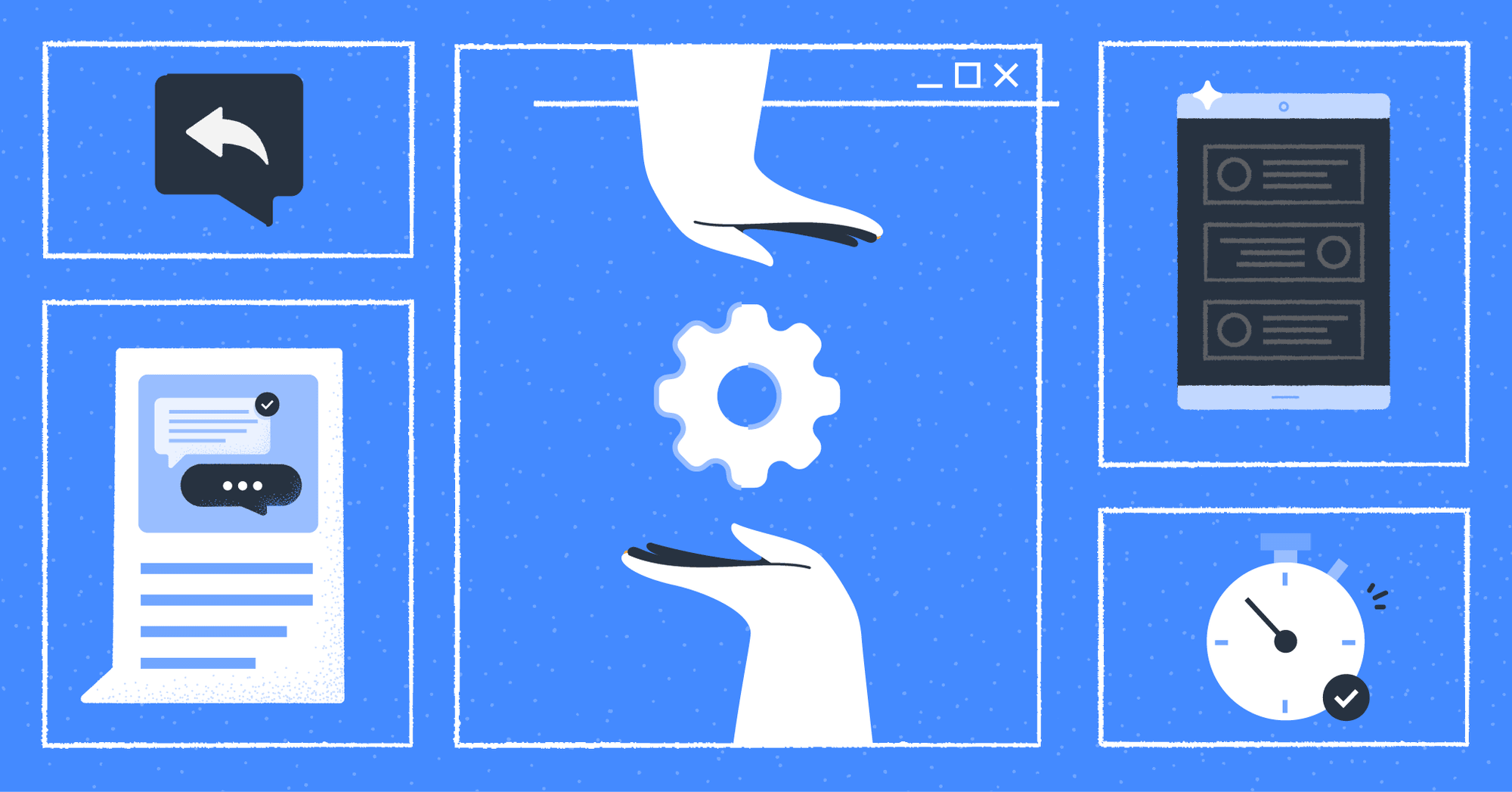For companies with several customer-facing teams, building a chat route can be challenging. However, companies that implement routing correctly see an improvement in the speed and quality of their conversations. This article will explain all you need to know about chat routing, including how to plan and execute chat routing strategies using the respond.io Workflows Module as a chat router.

What is Chat Routing?
Routing is the process that determines which team within a company will be responsible for handling a conversation. This will depend not only on the contacts’ needs but also on the way a company organizes its teams.
Dealing with instant messages and emails isn’t the same. When it comes to instant messaging, the speed at which routing needs to occur must be in near real-time to keep the customer satisfied.
Chat Routing vs Ticket Routing
Traditionally, businesses have been approaching routing via email with ticketing systems. But ticket systems have downsides when compared to chat routing, like the potential for delayed response times.
With ticket routing, customers need to submit a form or email and then wait for an agent to pick up the ticket. This waiting period can be frustrating for customers who require immediate assistance.
On the same note, ticket routing lacks real-time communication. Unlike chat routing, which enables quick back-and-forth exchanges through instant messaging channels, ticket-based systems may not offer the immediacy required to address complex or urgent issues.

Additionally, ticket routing often happens via email and seldom offers the same level of multichannel support as chat routing does.
Because many ticketing systems were built for traditional channels like email, they might not integrate seamlessly with social media or instant messaging platforms, limiting the ways customers can reach out.
While some do support those integrations, they generally can’t support the native channel features.
Since email interactions are slow and not conversational, ticket routing via email is not the best approach for simple inquiries that should be addressed swiftly. In fact, it can potentially slow down the overall issue-resolution process.
Routing instant messaging conversations and emails isn’t the same. When it comes to instant messaging, the speed at which routing needs to occur must be in near real-time to keep the customer satisfied. Let’s see how this can be achieved.
How Chat Routing Works
When customers encounter a query or need assistance, they can easily initiate a chat conversation through the company's website, app or instant messaging channel. This is often as simple as clicking on a chat widget or a chat link.
The process is designed to be user-friendly, ensuring that customers can quickly reach out for help without unnecessary hurdles.
Some routing systems request basic information from customers before routing them to a team via automated questions. Details such as the customer's name, email address or order number play a vital role in personalizing the conversation and most importantly, successful routing.

When dealing with returning customers, this information can be retrieved automatically from the business’ data bank, saving agents and customers time.
Once contacts are identified, the business’ routing logic comes into play. Some businesses will automatically route customers based on the provided data, while others will let customers choose their journey through interactive menus.
Next, we’ll explore some of the benefits of using chat routing to handle inbound conversations.
Chat Routing Benefits
Chat routing for businesses offers a range of benefits. First, it optimizes team utilization, making customer-facing operations more cost-effective by efficiently managing human resources.
Chat routing is easily scalable as a business grows, meaning that large companies can customize their own routing strategies for multiple specialized teams. This way, businesses can ensure conversations are routed to teams of experts in their field — for example, a technical support team.
Additionally, chat routing ensures a personalized customer experience, as returning or VIP customers can be directed to specialized teams, fostering stronger relationships with loyal clients.

One of the most significant advantages of chat routing is the reduction in conversation resolution time. By quickly directing customers to the right team and agent, issues are addressed promptly, resulting in higher first-contact resolution rates and improved customer satisfaction.
Overall, when the routing logic is correctly applied, chat routing significantly improves the customer experience. Faster and more relevant interactions play a crucial role in increasing customer satisfaction by promptly and efficiently addressing their needs.
Now that you are familiar with chat routing and its benefits, we’ll explain some of the most popular chat routing methods.
Chat Routing Methods
The following are some common ways companies use routing strategies to meet their business needs. They are just examples. Because every company functions differently, you should also find the routing strategy that best suits your company teams.
Before deciding on a routing method, there are two things you should do. First, list the customer-facing teams that will be involved. Second, define when to route conversations to one team versus another.
Chat Route Based on Team Function
Companies that choose this method handle customers from similar locations who speak the same language(s). Since language and time zone constraints are minimal, work is organized based on agent functions.
There are two ways to route conversations based on team functions. You can use a chat menu to ask the contacts in the conversation thread what team they want to talk to. This is best achieved with a multiple-choice question.

Alternatively, agents can ask contacts for their email and determine which team should attend to them by querying their customer data bank. In both cases, the contact will proceed along the branch of the desired function.
Chat Route Based on Contact Language
Contacts like to get support in their preferred language. That’s why this method is applied by companies with international audiences or operating in regions where people speak multiple languages.
Similar to function-based routing, you can get a contact’s preferred language by asking a question. If there have been previous interactions with the contact, you should save the contact language as a data value to avoid repetitive questions.

The number of branches should align with the number of languages that your company supports. Once the contact language is identified, they can proceed along the branch of the desired language to be routed to a team.
Chat Route Based on Team Shifts
Some companies receive messages at different times of the day, so they need to have customer-facing teams available for extended periods, if not round-the-clock.
Shift-based routing is intended to work around a company’s business hours, rather than contact data values. Branches are made based on team shifts, allowing businesses to route contacts to the current working team.

Thus, depending on the time of the day they start a conversation, contacts are routed to customer-facing teams with different operation hours. Companies that use this routing method often have international audiences.
To execute effective chat routing strategies, you’ll need an advanced, user-friendly automation builder. Respond.io’s Workflow Builder is designed to simplify business operations like chat routing.
Chat Routing with respond.io: The Basics
All respond.io users have access to the Workflows Module regardless of their plan. While Workflows can be created from scratch, this Module includes a list of Workflow Templates to help newcomers with respond.io automation.
On the respond.io app, navigate to the Workflows Module and click Add Workflow. Then, select Multi Team Routing: Multiple Choice by Contact. This is the Workflow Template we’ll use to guide you through the respond.io chat router basics.

A simple chat routing strategy usually has three steps:
- Ask a question
- Save the answer
- Build branches
Let’s see what happens in each one of these steps and why they are important for a successful chat routing strategy.
Chat Route Step 1: Ask a Question
The Ask a Question Step allows you to ask Contacts for relevant information. There are many different question formats you can use. Depending on your choice, the list of acceptable answers will change.
Multiple-choice questions are a popular way to get Contact information through discrete values. To make things simple, we’ve already built an Ask a Question Step with two discrete values: Talk to sales or support.

When Contacts get to this Step, they’ll have to make a choice. This will determine which team they’ll be routed to. Most importantly, the answers need to be saved to build subsequent Workflow Steps.
Chat Route Step 2: Save the Answer
When it comes to saving answers, there are two main possibilities. When one single value can be used in future conversations, the answer should be saved as Contact Field. If you request Contact emails before routing them, you can save their email address for future identification.
When Contacts choose between sales and support, their choice will only be useful for the current conversation. In scenarios like this, answers should be saved as dynamic variables.

Dynamic variables store information just for the time the Contact is traveling through the Workflow. Once the Contact leaves the chat router Workflow all data collected in variables can’t be used any longer. Now that we have collected the Contact answers, we can start building branches.
Chat Route Step 3: Build a Branch
How many Branch Steps should you add to a Workflow? The answer is simple. As many as the number of customer-facing teams you want to involve in your chat routing strategy. Because we are routing based on two team functions, this Workflow template comes with two pre-built branches by default.
To create a chat route, configure the specific conditions for each branch using the previously saved dynamic variables. Then, apply your agent assignment strategy at the end of each branch to assign Contacts to available agents.

To sum up, Contacts who start a conversation with your business will trigger the automated question. Then, their response will be saved as a variable. And based on that variable, they will be routed to the right team.
This section lays the foundations for using the respond.io Workflows Module as a chat router. But there is much more that can be done with it. We’ll discuss more routing possibilities in the following section.
Additional Chat Routing Techniques
Now you have some basic chat routing steps in place, which can be applied to route Contacts to Teams based on a single condition. However, companies that need more complex chat routing must do some extra setup.
Perhaps they have to handle customers using various conditions, route new and returning customers or effectively manage routing failure. Here are some ways you can make your chat router even more refined.
Multi-condition Branching Chat Route
As your business grows, so will the number and size of your company teams. Thus, you’ll probably need to fine-tune your routing strategy to handle more inquiries and coordinate teams with efficiency.
You can implement a multi-condition routing strategy by building branches with two or more conditions. This will allow you to execute more complex routing, such as routing a Contact to an English-speaking sales Team or a Spanish-speaking support Team.

Setting up multi-condition routing Workflows takes some extra amount of dedication. But because you can have up to four branches per Branch Step, you can build routes for multiple scenarios.
Chat Router for New and Returning Customers
Some businesses handle new and returning customers differently. With new customers, the focus often lies in enriching their profiles in a data bank for future identification and converting them into loyal customers.
Because existing customers have already provided their relevant data in previous interactions, they are quickly identified. The goal switches to routing these customers quickly and efficiently to the best Team and Agent to foster customer satisfaction and loyalty.
To implement this routing technique, use the respond.io Workflow Template named Routing: New & Returning Contacts.

This Workflow is already designed to route new and returning Contacts through two different branches. However, feel free to edit it to adjust it to your customer-facing teams and routing logic.
Don’t forget to use Send a Message Steps to communicate with customers as they are being routed to create a good impression and manage waiting time expectations.
Chat Router for High-value Customers
By prioritizing VIP Contacts, businesses can offer a more personalized and expedited service. Allocating a separate route for VIP Contacts enables efficient resource allocation, ensuring that highly skilled agents cater to their unique needs.
This approach not only enhances the overall customer experience but also fosters stronger relationships with loyal clients.

To implement this routing technique, use the respond.io Workflow Template named Routing: VIP Contacts.
This Workflow allows you to identify VIP Contacts when they start a conversation with your business. Contacts are qualified on your data bank through an HTTP Request Step. Then, VIP and regular Contacts are split into two different branches, which you can further develop with additional Steps.
Handling Chat Router Failure
Contacts that don’t fulfill the conditions of any of the routing branches are routed to the Else branch. This branch was designed to give businesses the option to circumvent routing failure.
However, Contacts will automatically exit the Workflow if this branch has no steps built into it.

Here’s one easy way to prevent it: Use the Else branch to assign Contacts to a supervisor and instruct him to complete the routing process with an internal comment.
Although supervisors will become occupied with these routing failures and exceptions, no Contacts will fall through the cracks. What’s more, you can learn from common routing incidents to improve the chat router Workflow further.
In conclusion, chat routing saves you money, time and resources while keeping customers satisfied with prompt and effective service. For that reason, make sure to use an advanced automation builder designed for scalability.
Respond.io features a full-fledged Workflows Module and many other features to take business messaging to the next level. To get started with chat routing, try respond.io for free!

Further Reading
If you’ve found this article useful, here are some additional readings that might interest you.
- WhatsApp Automation: A WhatsApp Business Automation Guide
- How to Use Automation to Enhance Customer Service Efficiency
- What is CSAT? The Customer Satisfaction Process Guide



























